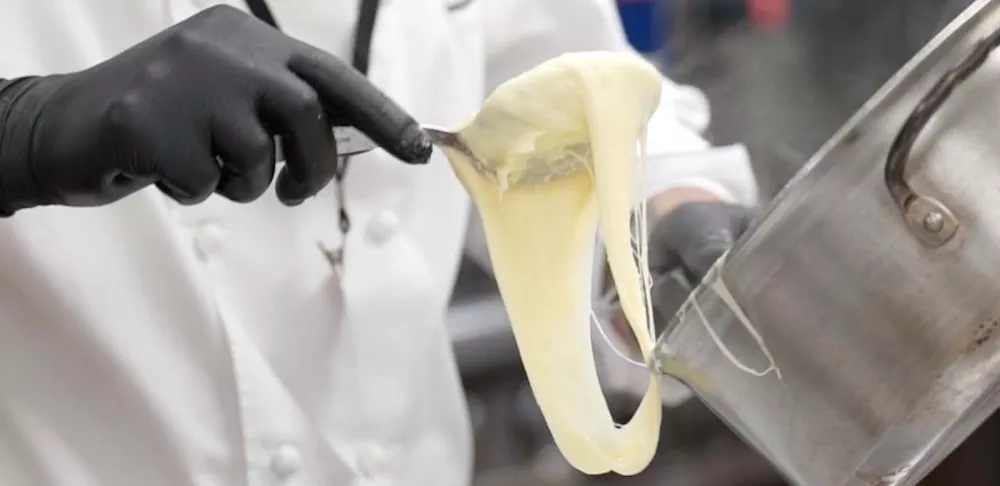A fellow cheese pro once offered me the following wisdom: "Italian cheeses are cooking cheeses. French cheeses are snacking cheeses."
This makes a certain degree of sense when you consider the most famous cheeses from both Italy and France.
While Parmigiano-Reggiano and Pecorino are perfectly excellent to snack on in their own right, it's their transformation of simple dishes into complex, savory masterpieces that make them memorable. Meanwhile, French stalwarts such as Brie de Meaux, Époisses and Roquefort are better known for their prowess on a cheese plate paired with little more than a baguette than as the star of a composed dish. To the best of my knowledge, France doesn't have a version of cacio e pepe; a pasta where a hollowed-out wheel of cheese serves as a cooking implement.
That being said, France of course has its fair share of iconic, cheese-forward dishes: soufflé, croque monsieur and soupe a l'oignon, to name a few, and certain French cheeses have a very specific place in the French culinary canon.
Here, we get to know four French cheeses with important culinary applications.
Comté
Hailing from the Jura region of Southwest France, Comté is France's version of Switzerland’s Gruyère, and arguably the most important French cheese when it comes to its use in cooking. Fondue, soufflé, croque monsieur, soupe a l'oignon, gougères and even some quiche recipes all rely on Comté to give them a certain oomph. Why? In addition to Comté's flavorful, complex, savory character, its real power is in its meltability.
Alpine cheeses like Comté, whether they hail from Switzerland, France, Italy or even Austria, have several things in common. They are typically made from raw milk, which produces the most savory cheeses. They are all also washed rind cheeses, which can produce bold, pungent flavors, however, the large format of this type of cheese means that its boldness comes though less as funk, and more as a meaty, oniony flavor. The most important characteristic, however, is cheeses like Comté are all cooked curd cheeses, meaning gentle heating during the initial stages of cheesemaking knits the curds together in such a way that creates their signature, desirable stretch when heat is applied again during the cooking process.
Related reading: All About Alpine Cheese
Chèvre
Chèvre means "goat" in French, and is the simplest of the French cheeses when it comes to culinary applications. Chèvre is a fresh goat's milk cheese, meaning it spends no time aging and therefore forms no rind once its curds have been formed, shaped and drained of excess whey.
Tangy and bright, its primary use outside of a simple cheese plate is in salads, but a classic French bistro salad — salade de chèvre chaud — gives slices of chèvre a brief sauté treatment to add caramelization and complexity to the medallions. Paired with tender leaves of butter lettuce and a sharp dressing, the chèvre also gets an assist from both lardons and nuts for salad the way only the French can do, deep with both flavor and texture.
Related reading: Understanding Goat Cheese
Tomme Fraîche
Various French dishes rely on a young, slightly sweet, milky cheese called tomme fraîche for its creamy, tangy character. Examples of dishes that use tomme fraîche include pommes aligot, whipped potatoes with cheese, and truffade, a tangle of potatoes in a cheesy cream sauce.
While its creation process is different, tomme fraîche has an impact similar to cream cheese in its usage.
Tomme fraîche typically comes from the south central region of France, and is made from an unsalted cow's milk that is lightly fermented. In cheese culture, tomme typically refers to various kinds of cheese that share a similar shape: a small round format that can be made from any type of animal milk. Tomme fraîche, however, doesn't always come in the signature shape but is always made with cow's milk. Like Comté, it is an excellent melter, and a fine choice for gratins, flatbread or any melting opportunity where a mild-flavored cheese is preferred.
Reblochon
The strongest and potentially softest of the cheeses here, Reblochon's culinary application is singular: as the basis for the Alpine dish tartiflette. Tartiflette is a composed dish that includes potatoes, ham and onions topped with a smear of the soft-ripened cheese. Unlike Raclette, which typically tops similar ingredients in a more contained way, the use of softer Reblochon renders tartiflette almost like a soup.
Reblochon is considered a smear-ripened or washed rind cheese, meaning that a frequent application of brine throughout the aging process encourages certain microbes that create a sticky, pungent exterior and contribute to the cheese's umami, earthy interior. As Reblochon is a young, unpasteurized cheese, it is not available in the US, but similar style cheeses include other soft and strong cheeses such as fontina or taleggio.
Related reading: Understanding Cheese Rinds






